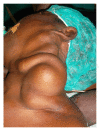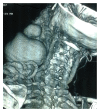Giant Arteriovenous Malformation of the Neck
- PMID: 26347847
- PMCID: PMC4546949
- DOI: 10.1155/2015/124010
Giant Arteriovenous Malformation of the Neck
Abstract
Arteriovenous malformations (AVM) have a wide range of clinical presentations. Operative bleeding is one of the most hazardous complications in the surgical management of high-flow vascular malformations. In the cervical region, the presence of vital vascular structures, such as the carotid artery and jugular vein, may increase this risk. This is a case of massive arteriovenous malformation deforming the neck and the face aspect of this aged lady and growing for several years. A giant mass of the left neck occupied the carotid region and the subclavian region. The AVM was developed between the carotid arteries, jugular veins, and vertebral and subclavian vessels, with arterial and venous flux. The patient underwent surgery twice for the cure of that AVM. The first step was the ligation of the external carotid. Seven days later, the excision of the mass was done. In postoperative period the patient presented a peripheral facial paralysis which completely decreased within 10 days. The first ligation of the external carotid reduces significantly the blood flow into the AVM. It permitted secondarily the complete ablation of the AVM without major bleeding even though multiple ligations were done.
Figures






References
LinkOut - more resources
Full Text Sources
Other Literature Sources

